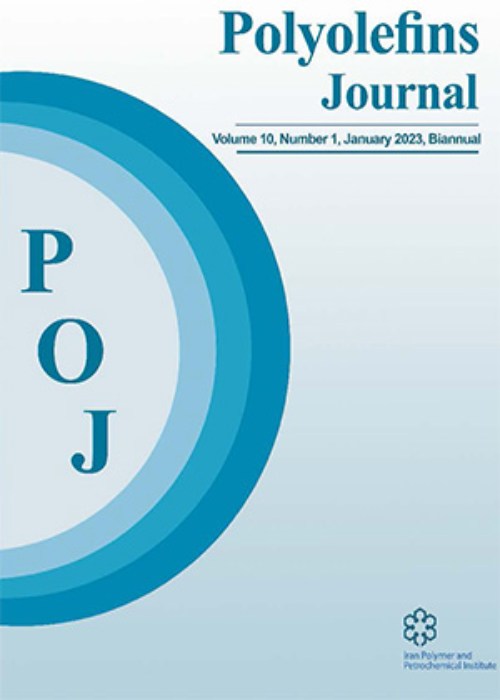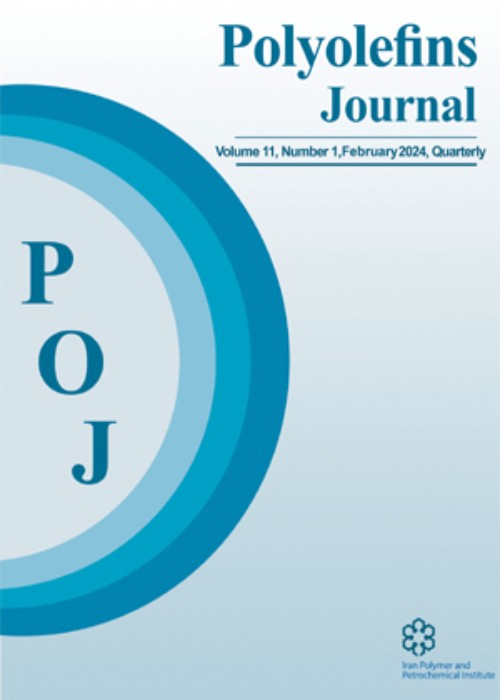فهرست مطالب

Polyolefins Journal
Volume:10 Issue: 1, Winter 2023
- تاریخ انتشار: 1401/11/23
- تعداد عناوین: 6
-
-
Pages 1-11Thermo-mechanical recycling process is the cheapest way to recover plastic waste such as LDPE with low ecological impact. Thus, the goal of this work is to obtain high-performance microcomposites from polyvinyl chloride (PVC), recycled low-density polyethylene (r-LDPE), calcium carbonate (CaCO3), and calcium/zinc stearate (CaSt2/ZnSt2). The effect of the two ratios of thermal stabilizers with different concentrations on the mechanical properties and thermal stability of PVC and PVC/r-LDPE (1:1) blend was studied. The samples were characterized using infrared spectroscopy (FTIR), mechanical tests, thermal analysis, and scanning electron microscopy (SEM). The addition of 5 phr of CaSt2:ZnSt2 (9:1) to PVC (MC4) resulted in optimal tensile strength and elongationat-break values. In addition, MC4 showed high thermal stability. Moreover, the incorporation of r-LDPE into PVC made the PVC matrix stronger and more stable than pure PVC, which yields high mechanical and thermal performances. Furthermore, an outstanding synergistic effect is obtained when a heat stabilizer rich in calcium is combined with CaCO3 and r-LDPE. This PVC/r-LDPE blend as a composite can be used in several industrial fields.Keywords: Polyvinylchloride, recycled-low density polyethylene, thermal stabilizer, calcium carbonate
-
Pages 13-20
Varying amounts of a high molecular weight poly(1-hexene) (PH, Mv=1.7×106 Da) are substituted for EPDM in an iPP/iPP-g-MA/EPDM blend (weight ratio: 76:4:20) and mechanical properties as well as phase morphology of the blends are studied and compared. The results show that by substituting the entire EPDM with PH, the tensile strength-at-break increases from 18.7 to 21.1 MPa, elongation-at-break increases from 15.5% to 370.8%, and impact strength increases from 6.4 to 50.1 kJ.m-2. Dynamic mechanical thermal analysis (DMTA) of the blends proved their immiscibility and SEM analysis confirmed these findings by showing droplet-matrix morphologies. Studying the creep behavior of the samples shows that the blends containing PH have more creep so that by substituting all EPDM in the blends with PH, the permanent deformation increases from 0.425% to 0.505%. According to the results, PH is introduced as a candidate for improving the impact properties of iPP/iPP-g-MA/EPDM blend.
Keywords: Rubber toughened iPP, Creep behavior, Two phase morphology, DMTA, Immiscible blends -
Pages 21-26Dimethylbenzylidene sorbitol (DMDBS) is a common nucleating/clarifier agent used in polypropylene (PP). So many researchers have looked at different aspects of incorporating this additive on crystallization behavior of PP. The current study has focused on a rather new subject and that is the role of carrier resin of DMDBS masterbatch on the rheological behaviour of polypropylene. This goal has been achieved through studying the role of carrier resin on phase separation behavior of DMDBS upon cooling. It has been shown that a permanent bonding forms between the molecules of carrier resin and DMDBS in the masterbatch and this bonding slows down the crystallization kinetics of DMDBS in the final blend which in turn, influences its rheological behavior. Frequency sweep experiments conducted on a block co-polypropylene showed that lower values of storage shear modulus (G’), loss shear modulus (G’’), and complex shear viscosity (ɳ*) are observed if DMDBS is incorporated in the form of masterbatch. Interestingly, a different effect was observed when the masterbatch constituents were employed directly into the polypropylene, illustrating the importance of the mentioned bonding between DMDBS and the carrier resin in the masterbatch.Keywords: Polypropylene, Nucleating agent, Masterbatch, Rheology, phase separation
-
Pages 27-33
In the present work, the ability of wood-plastic composite containing high density polyethylene and wood powder as a recycled material to remove methylene blue cation pigment was studied. The effect of some important parameters such as pH, adsorbent amount and contact time was investigated. Adsorption efficiencies for methylene blue were maximized at alkaline pH. Adsorption capacity increased with increasing adsorbent amount and contact time. The value of R2 in Langmuir model was equal to 1 and the separation factor for 0.5 and 1 g of adsorbent was 0.09 and 0.1, respectively. Given that the methylene blue adsorption data were more consistent with the Langmuir isotherm model, it can be stated that the wood-plastic composite probably has uniform adsorption surfaces and the adsorption process occurred in a homogeneous system on the adsorbent surface. Based on the results of this study, it was observed that this composite is a suitable adsorbent for removing methylene blue from aqueous solutions and used as a purifying agent in the decolorization of effluents containing pigments. This adsorbent is recyclable and cost-effective for dye removal from textile industry wastewater.
Keywords: Wood plastic composite, adsorption, Methylene blue, Langmuir Isotherm -
Pages 35-43The substituents on cyclopentadienyl (Cp) can regulate the electronic effect and hindrance of the active center in the metallocene catalyst. This modification can greatly change the catalytic activity of the catalyst and affect some features of the polymer. In order to study the effect of alkyl substituents on Cp in the performance of a typical metallocene catalyst Cp2TiCl2 for ethylene polymerization, two types of catalyst active centers were designed, including non-bridge Cp2(R)TiCH3]+ and bridge [NCP2 (R)TiCH3]+ (R = H, Me, iPr). The effects of alkyl substituent steric hindrance were explored by density functional theory on the complex of catalyst active center with ethylene and the formation of transition state. The results showed that the increase of substituent steric hindrance was unfavorable to complex between ethylene monomer with catalyst active center. Moreover, the bigger alkyl substituent, the greater the activation energy of ethylene insertion into catalyst active center and the more difficult is ethylene polymerization. Therefore, the performance of metallocene catalysts could be regulated by the substituent on Cp.Keywords: Titanocene, Ethylene polymerization, mechanism, Hindrance effect, Density functional theory
-
Pages 45-57Polyvinylpyrrolidone (PVP) composites based on rice husk (RH), rice husk carbon (RHC, i.e., black rice husk ash (BRHA)) and rice husk ash (RHA, i.e., white rice husk ash (WRHA)) were prepared separately through solution casting method. Similar composites were made using polystyrene (PS) through the same protocol. The carbon and ash obtained from this type of rice husk were obtained via pyrolysis at 300 and 600 °C, respectively, for 1 hour. The effects of these additives on the spectroscopic characteristics of polymers were verified by examining the infrared (FT-IR) and X-ray diffraction (XRD) spectra of the prepared composites. The resulting showed a remarkable difference between the spectra of parent polymers and the corresponding composites. Changes in peak width and 2θ parameters (observed in XRD patterns) revealed that PVP possesses better interactions with RHC, while PS has better interactions with RHA. Due to the high hydrophilicity of PVP, some investigations were accomplished on the hydrophilic properties of PVP samples. Polystyrene did not reveal detectable water vapor absorption (WVA), thus this experiment was not carried out for PS samples. Eventually, it was disclosed that there are significant discrepancies between the hydrophilic properties of PVP and its composites. In the other word, the WVA decreased from 290% for parent PVP to 210% for PVP-RHC composite.Keywords: polyvinylpyrrolidone, Polystyrene, Rice husk derivatives, bio-composite, Spectroscopic, hydrophilic characteristics


